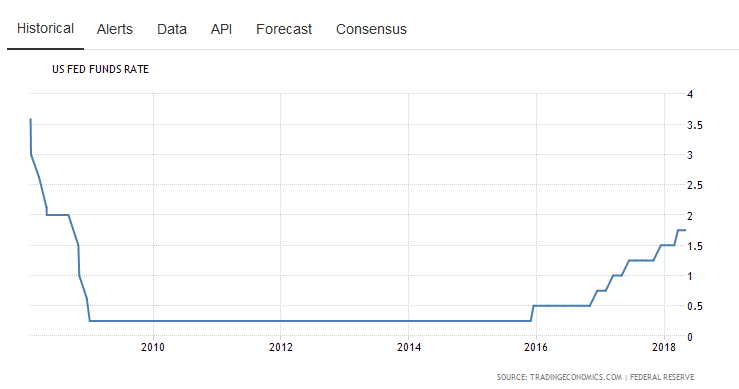Yahoo News is reporting today that jobless claims expectantly fell last week. (Why was it unexpected–the trend has been going downward for a while?) Because of this, the Federal Reserve is expected to raise interest rates next week to keep the economy from overheating. I have mixed emotions about this. We do have to get back to reasonable interest rates, but it seems as if the federal reserve also has a habit of overreacting and slowing down (or speeding up) the economy a little too quickly.
This is a chart of interest rates starting in approximately 2008 taken from trading economics:
 As you can see, the rates were kept very low during the Obama Administration in order to avoid an economic crash. Ideally, the Federal Reserve will raise them very slowly so as to protect the economic growth we are currently seeing.
As you can see, the rates were kept very low during the Obama Administration in order to avoid an economic crash. Ideally, the Federal Reserve will raise them very slowly so as to protect the economic growth we are currently seeing.
Yahoo News reports:
The dollar was trading lower against a basket of currencies. Prices for longer-dated U.S. Treasuries rose marginally and stocks on Wall Street were mixed. The labor market is considered to be close to or at full employment. Nonfarm payrolls increased by 223,000 jobs in May and the unemployment rate dropped to an 18-year low of 3.8 percent.
The jobless rate, which has declined by three-tenths of a percentage point this year, is now at a level where the Fed projected it would be by the end of this year.
The number of people receiving benefits after an initial week of aid increased 21,000 to 1.74 million in the week ended May 26. The four-week moving average of the so-called continuing claims dropped 13,250 to 1.73 million, the lowest level since December 1973.
…The strong job market conditions were also underscored by the publication on Thursday of the Labor Department’s Contingent and Alternative Employment Arrangements survey, which showed 1.3 percent of U.S. workers in May 2017 held jobs they considered temporary or did not expect to last beyond a year.
That is a decline from 1.8 percent in February 2005 when the government last conducted a similar survey.
When self-employed individuals and independent contractors were included, the share of workers was 1.6 percent in May 2017, down from 2.3 percent in February 2005. Most contingent workers were under the age of 25.
The Labor Department will publish its Contingent Worker Supplement report in September. It is expected to shed light on the so-called gig economy.
Like him or not, President Trump is a successful businessman who understands how economics works. It might be a good idea in the future to elect businessmen to the presidency instead of politicians.
